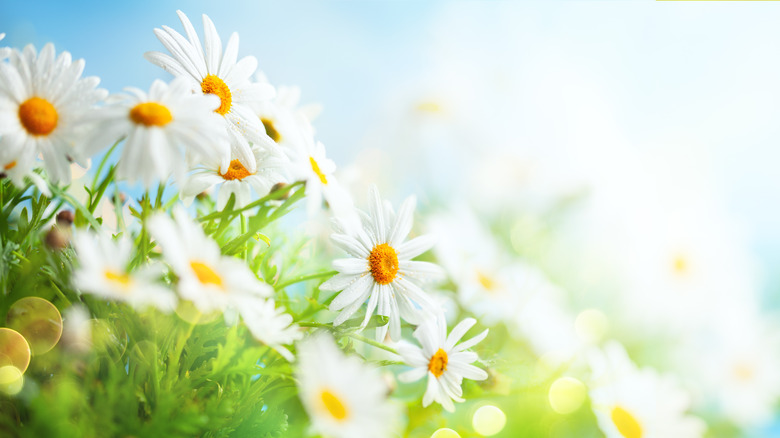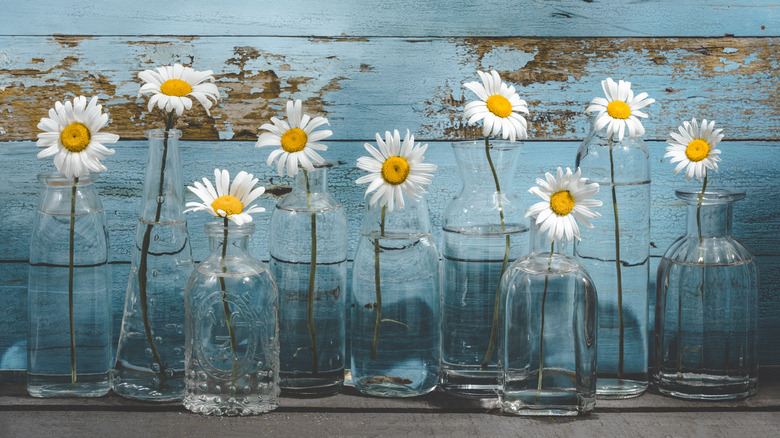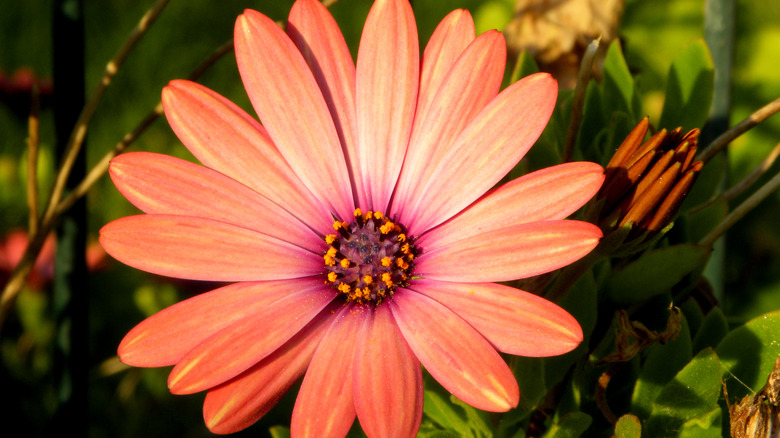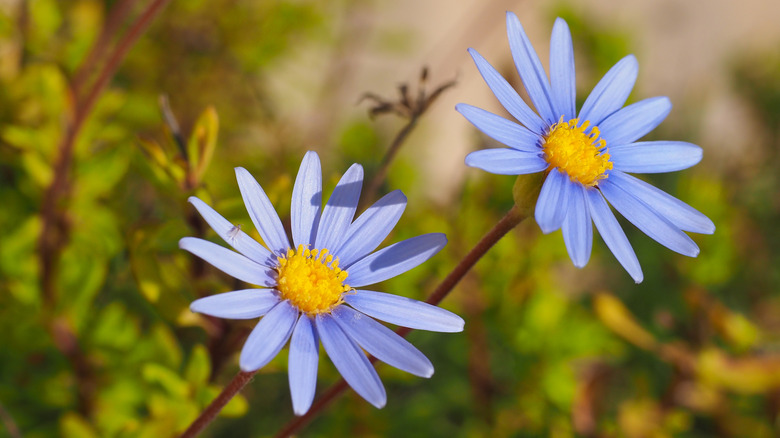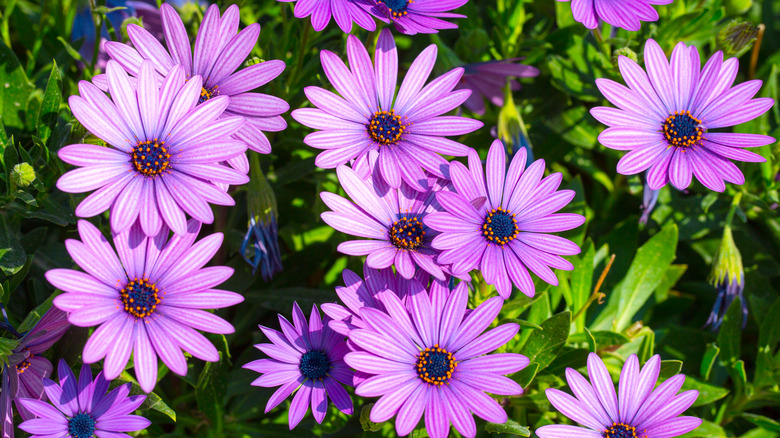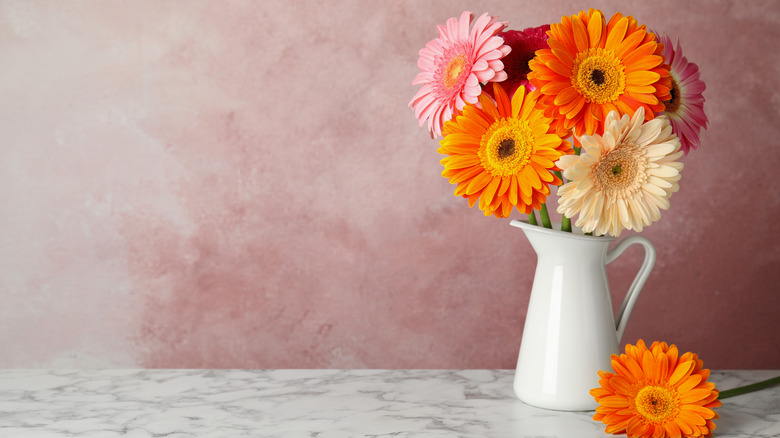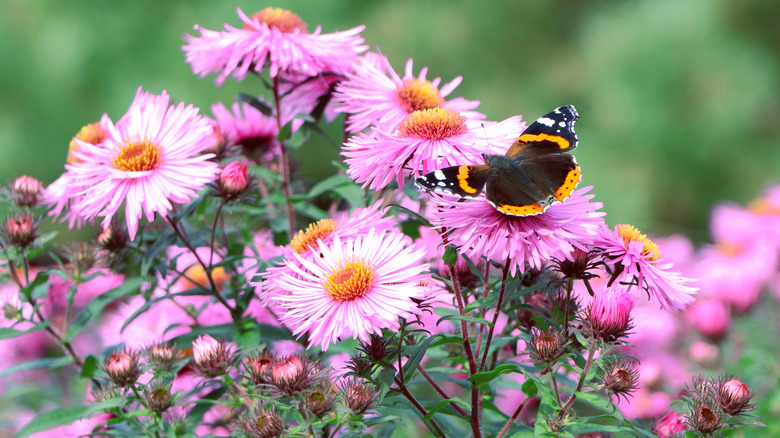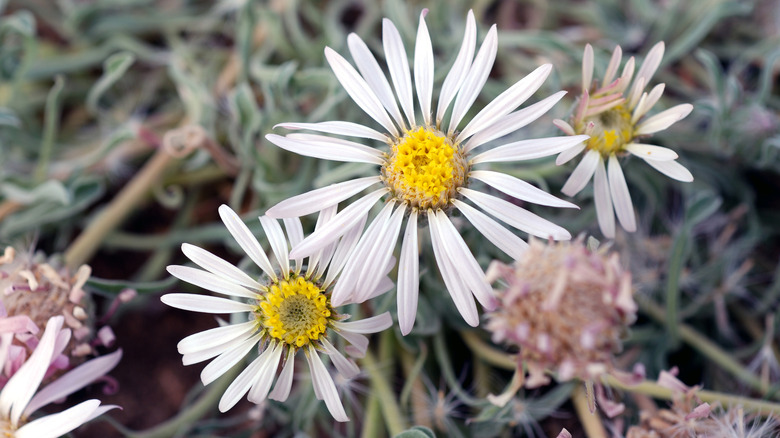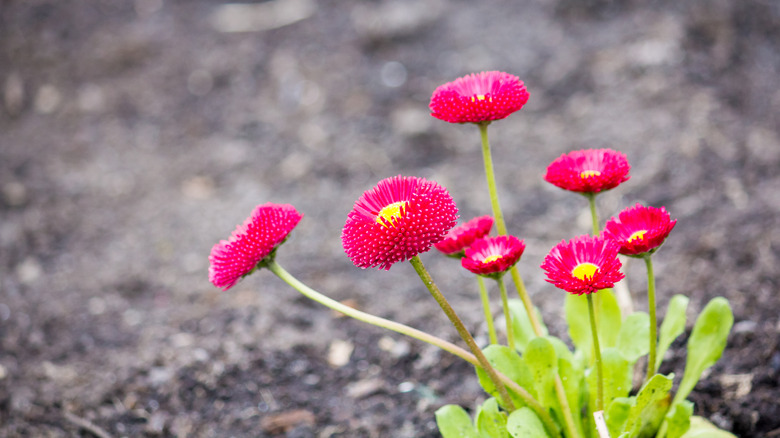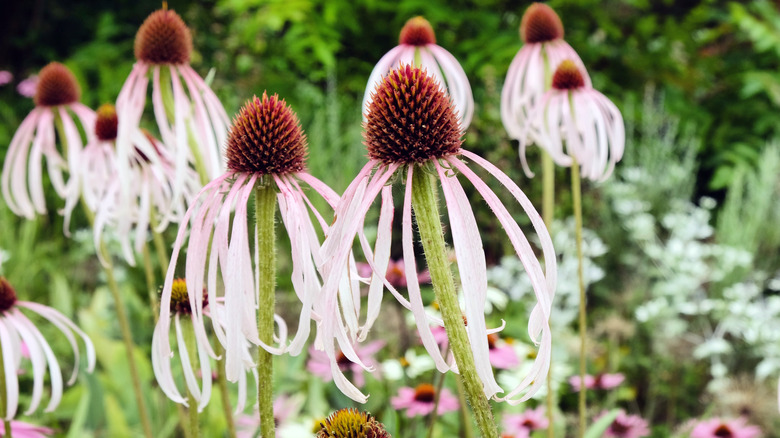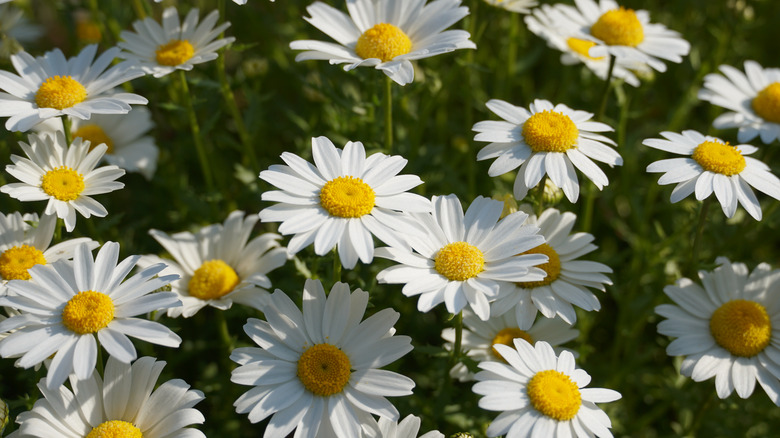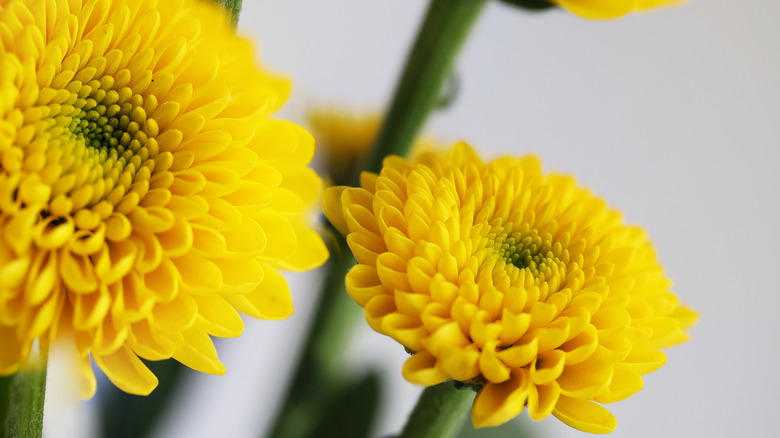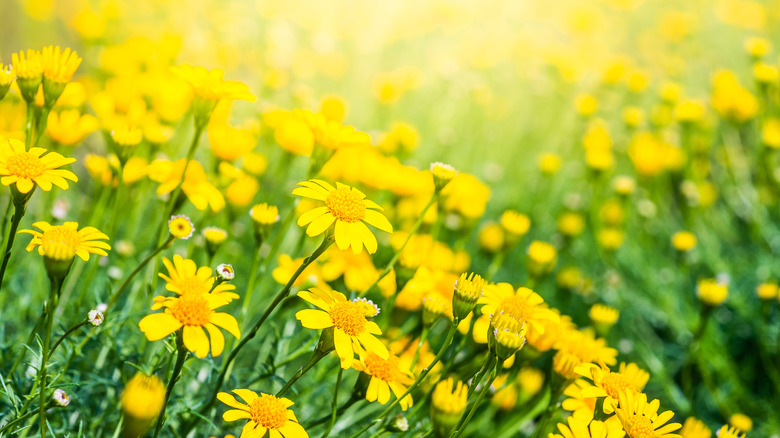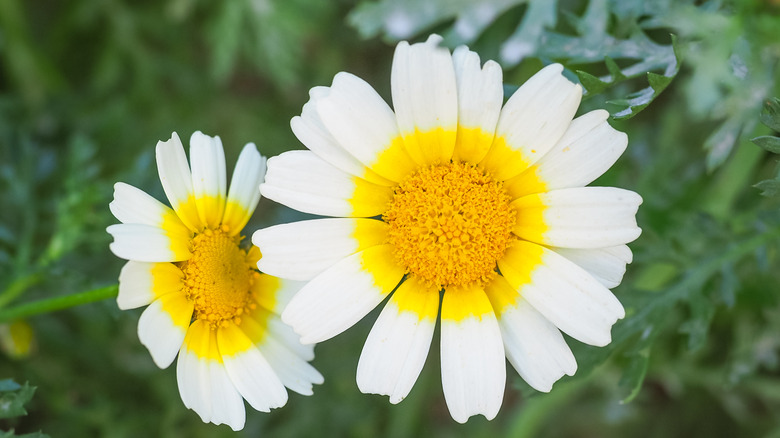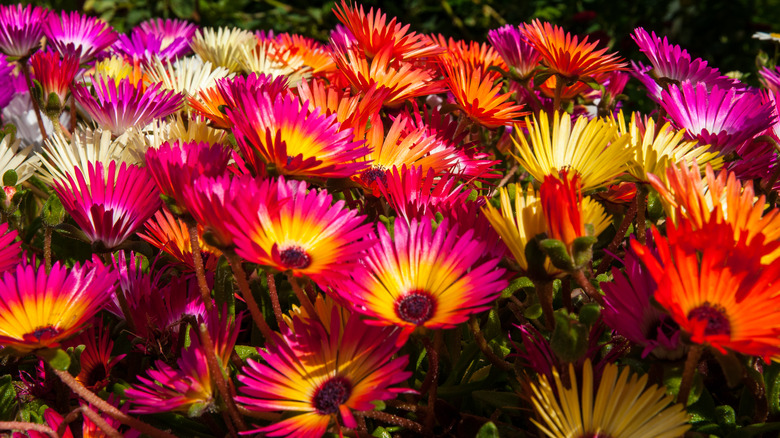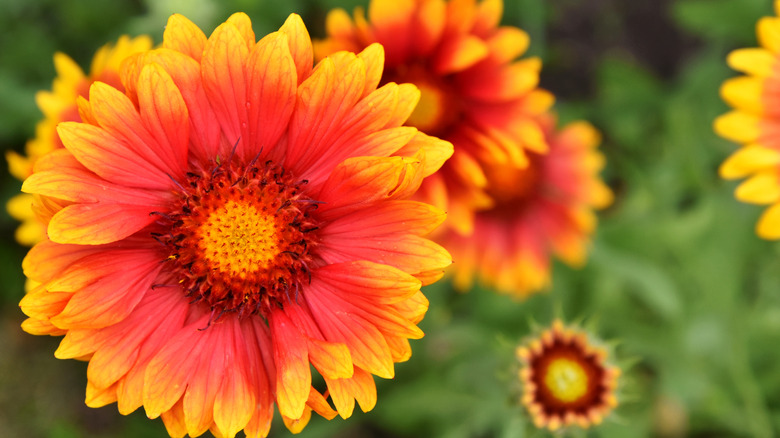15 Types Of Daisies That Will Look Perfect In Your Flower Garden
If you're looking to fill your flower garden with a vibrant, cheery flower that comes in countless colors and sizes, the daisy is the right choice for you. This flower is reliable and easy to grow, making it a great option to add pops of color to your outdoor landscape. The best part is that you can grow daisies in a variety of climates as they are a hardy bloom, resistant to drought, and continue to delight gardeners with new blooms throughout the summer and the fall, according to Country Living.
Before choosing one (or several) of the many types of daisies that exist in any garden store, it's always a good idea to take a peak at the USDA plant hardiness zone map in order to determine whether this flower will thrive in your garden, and under what types of conditions as well as during which seasons. It is also important to make sure your garden provides quality soil for your daisies, and if not, how you can boost the quality with store-bought mixes and mulches. The amount of sun that your daisies need on a daily basis will also depend on the type. If you're trying to narrow down the variety of daisy to buy for your garden, scroll through the following slides for a glance at 15 types of daisies that will look perfect in your yard.
1. Shasta daisy
When people think of daisies, they most likely imagine the Shasta variety (scientific name Leucanthemum x superbum). This type is popular due to its classic white blooms with a yellow center. Many gardeners choose this variety for its seasonal blooms as well as its tendency to provide dark-green foliage year round, per Gardening Know How. According to Garden Design, the Shasta daisy offers many other benefits, including resistance to disease and drought and a penchant for attracting butterflies.
Bloom Season: spring or early summer through fall
USDA Growing Zone: zones 4 to 9
Growing Conditions: light sun, partial shade
Soil Type: fertile soil with good drainage (take care not to overwater)
Size: ranges from a few inches to 3 feet in height and 1 to 2 feet wide
2. African daisy
If you're looking for a colorful daisy, look no further than the African daisy (scientific name Osteospermum spp), which is native to Africa and Asia. With its orange, magenta, and yellow petals, this flower is the perfect addition to any outdoor space. According to The Spruce, there is plenty of variety within this type of daisy when it comes to size and color. The petals are similar to the Shasta variety in terms of size and shape, although there are certain types of African daisies that feature beautiful, tubular-shaped petals.
Bloom Season: spring through fall
USDA Growing Zone: zones 9 to 11
Growing Conditions: full sun
Soil Type: damp soil with good drainage
Size: ranges from 1 to 3 feet in height and 1 to 2 feet wide
3. Blue marguerite daisy
The blue marguerite daisy (scientific name Felicia amelloides) is aptly named due to its periwinkle petals that contrast beautifully with its yellow center. Combined with other daisy varieties, this flower often adds a focal point to a garden bed or container. Better Homes & Gardens recommends pairing the blue marguerite daisy with white and silver plants to give your garden an air of sophistication or with orange and yellow blooms for a bolder look.
Bloom Season: spring and summer
USDA Growing Zone: zones 10 and 11
Growing Conditions: dry and cool climates with at least six hours of full sun per day coupled with afternoon shade during hot summer days
Soil Type: well-draining soil
Size: ranges from 1 to 3 feet in height and 1 to 2 feet wide
4. Cape daisy
The cape daisy (scientific name Osteospermum ecklonis) comes in two color schemes: The first is a creamy white bloom with a purple center and the second is a fully purple bloom with streaks of white along the petals and the same purple center. According to American Meadows, this lovely flower attracts bees and butterflies with its fragrant scent and eye-popping colors. It is easy to grow and can be planted in both garden beds and containers.
Bloom Season: from late spring to early summer
USDA Growing Zone: zones 3 to 10
Growing Conditions: ample sun; plenty of water and fertilizer during the growing season
Soil Type: well-draining and slightly acidic soil
Size: ranges from 1 to 2 feet in height and 1 to 2 feet wide
5. Gerbera daisy
The gerbera daisy (scientific name Gerbera jamesonii) hails from South Africa and is known for its large, multi-layered blooms that come in a wide variety of bright colors, per Gardening Know How. Since the gerbera variety offers so many options to choose from, consider where you will be planting your daisies (flower bed, container, etc.) to determine the ideal size to purchase. With the right soil, water, and sun conditions, your gerbera daisies will flourish in a variety of outdoors spaces.
Bloom Season: summer and fall
USDA Growing Zone: zones 8 to 10
Growing Conditions: full sun and partial shade (gerbera daisies do not like extreme heat)
Soil Type: well-draining, generously watered, and slightly acidic soil
Size: ranges from 10 to 18 inches in height and 9 to 12 inches wide
6. Aster daisy
The aster daisy or michaelmas daisy (scientific name Aster spp.) includes the common New England and New York varieties, according to The Old Farmer's Almanac. This variety features multiple pointy, thin petals surrounding a yellow center while popular colors include purple, blue, and pink. In fact, the flower was named after the Greek word for star due to the star-like appearance of its blooms. If you love a garden full of pollinators, this flower is the perfect choice as it attracts bees and butterflies with its plentiful supply of nectar that continues late into the fall.
Bloom Season: summer and fall
USDA Growing Zone: zones 6 to 10
Growing Conditions: full sun and moderate watering
Soil Type: moist, fertile, and loamy
Size: up to 3 feet in height and width
7. Easter daisy
The Easter daisy (scientific name Townsendia incana) is one of the smallest varieties of daisy, often found growing low to the ground and in rocky environments, according to American Southwest. If you have a rock garden or a yard with grittier soil, this plant will be the perfect addition to give your space a pop of color. The Easter daisy features white petals with a yellow center, similar to the Shasta daisy. However, it is also known for growing small, fine white hairs along the stems and leaves that give it a silver appearance. While leaf and petal size varies, all Easter daisy types thrive in dry and sandy locations.
Bloom Season: spring and summer
USDA Growing Zone: zones 3 to 9
Growing Conditions: full sun
Soil Type: moist and gritty with good drainage
Size: 3 to 8 inches in height
8. English Daisy
The English daisy (scientific name Bellis perennis L.) is another small variety of daisy that comes in several different colors, ranging from white to bright pink, per Gardening Know How. The bloom is fluffy in appearance with curved petals that face upwards, surrounding the classic yellow center. One tip to making sure this flower thrives in your garden is to bury the root system deep in the soil. Maintenance is relatively easy and consists of deadheading flowers and watering regularly. The English daisy does not appreciate drought conditions nor extreme heat.
Bloom Season: spring, summer, and fall
USDA Growing Zone: zones 4 to 10
Growing Conditions: partial sunlight; cool weather
Soil Type: moist and lean (not too fertile)
Size: 6 to 12 inches in height and width
9. Pale purple coneflower
The pale purple coneflower (scientific name Echinacea pallida) is a large variety of daisy that is native to eastern and central North America, notes the Missouri Botanical Garden. The unique appearance is marked by a cone-like center covered in small spiky hairs and a skirt of long, drooping petals in shades of white, pink, and purple. You'll find that this plant is extremely adaptable, thriving in extreme weather and soil conditions. While not a high-maintenance variety, you may need to separate clumps of pale purple coneflowers when they become overcrowded every few years.
Bloom Season: June and July
USDA Growing Zone: zones 3 to 10
Growing Conditions: full sun for part of the day and partial shade for the rest
Soil Type: dry with good drainage
Size: 2 to 3 feet in height and 1 to 2 feet in width
10. Ox-eye daisy
The ox-eye daisy (scientific name Leucanthemum vulgare) is one of the most common types of daisy that is easily recognizable for its white petals and large, yellow centers. While similar in appearance and color to the Shasta daisy, the ox-eye is much larger, according to Minnesota Wildflowers. The center of the flower is also larger, measuring around 3/4 inch across. This daisy was introduced into the U.S. in the 1800s and quickly became an invasive species. However, when properly cared for, the ox-eye daisy can be a non-invasive addition to any garden.
Bloom Season: May through August
USDA Growing Zone: zones 3 to 8
Growing Conditions: full sun for part of the day and partial shade for the rest
Soil Type: mildly acidic with good drainage
Size: 1 to 3 feet in height and 1 to 2 feet in width
11. Florist's daisy
The florist's daisy (scientific name Chrysanthemum x morifolium) is unique in appearance when compared to the more traditional varieties of daisy. The petals are curved in small scoops and face towards the sky while radiating out from the center in thick layers. This flower is a popular choice in floral arrangements, providing bouquets with pops of color. According to Go Botany, this bloom serves an additional purpose as a key component of traditional Chinese medicine. The flower is said to reduce the symptoms associated with nervous system disorders.
Bloom Season: autumn
USDA Growing Zone: zones 5 to 8
Growing Conditions: full sun during part of the day and light shade during the rest; minimal fertilizer
Soil Type: moist soil with good drainage
Size: 1 to 3 feet in height and width
12. Dahlberg daisy
Dahlberg daisies (scientific name Thymophylla tenuiloba) are a gorgeous wildflower that grow in wide swatches and brighten up any outdoor landscape with their sunny yellow hue. According to Fine Gardening, this plant is commonly found in North and Central America and gives off a fragrant scent that attracts pollinators. If you're looking to add Dahlberg daisies to your garden, consider using them to line paved pathways or to add color to a rock garden. This variety of daisy is very low maintenance and resistant to drought.
Bloom Season: late summer
USDA Growing Zone: zone 11
Growing Conditions: full sun and infrequent watering
Soil Type: well-draining soil with dry to medium moisture
Size: 6 to 12 inches in both height and width
13. Crown daisy
The crown daisy (scientific name Glebionis coronaria) is native to the Mediterranean region and is cultivated in East Asia and North America. The green foliage of the plant is also commonly used in Asian cuisine, according to Health Benefits Times. If you're looking to grow this flower for consumption, you'll be delighted to learn that crown daisy greens offer a kick of antioxidants and plenty of vitamins and minerals. The various components of the plant are also used in traditional Eastern medicine and can reportedly treat maladies ranging from inflammation to kidney stones and gonorrhea.
Bloom Season: early spring to early fall
USDA Growing Zone: zones 3 to 9
Growing Conditions: can thrive in both full sun and partial shade
Soil Type: fertile, moist, and well-draining soil (crown daisies do not tolerate drought)
Size: two to three feet in height
14. Livingstone daisy
The Livingstone daisy (scientific name Dorotheanthus bellidiformis) is one of the most vibrant types of daisy, featuring eye-popping colors of magenta, yellow, orange, red, and pink. The blooms have spiky petals that surround a darker center. Most petals boast multiple colors that radiate from the center in a cyclical fashion. If you choose this type of daisy for your garden, you can enjoy a long bloom period through the spring and summer, as per How Stuff Works. This flower is the perfect choice for anyone living near the ocean as it is resistant to sea spray and soil high in salt.
Bloom Season: spring and summer
USDA Growing Zone: zones 9 to 10
Growing Conditions: full sun (but can sunburn in extreme heat)
Soil Type: sandy and well-draining soil
Size: up to 8 inches in height and 1 foot in width
15. Gaillardia daisy
The gaillardia daisy or blanket flower (scientific name Gaillardia x Grandiflora) receives its common name due to the way it encroaches upon a space and covers it like a blanket, says The Spruce. Gardeners are rewarded with the stunning blooms that resemble a sunset in color with hues of pink, yellow, orange, and red. The flowers spread outwards around a yellow-red interior in multi-layered rings. When left to grow in the wild, this flower will overtake a space. However, it can also be easily cultivated to thrive in garden beds and containers.
Bloom Season: summer and fall
USDA Growing Zone: zones 3 to 10
Growing Conditions: full sun and partial shade in hot climates; due to being drought tolerant, avoid overwatering
Soil Type: well-draining soil; can tolerate moist soil but not clay
Size: 1 to 2 feet in both height and width
